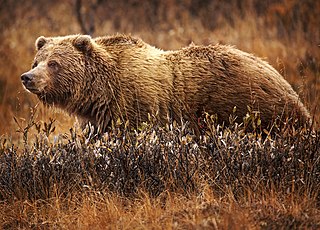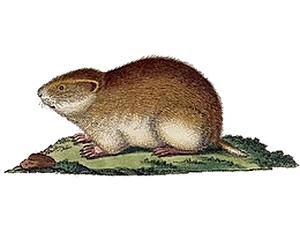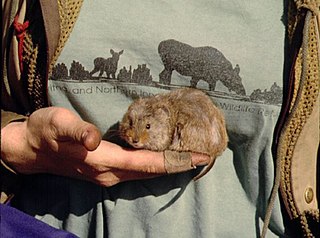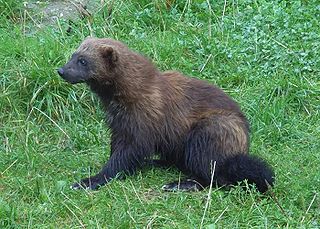 W
WThe ABC Islands bear or Sitka brown bear is a subspecies or population of brown bear that resides in Southeast Alaska and is found on Admiralty Island, Baranof Island, and Chichagof Island of Alaska. These islands have the colloquial name of the ABC Islands and are a part of the Alexander Archipelago. This brown bear population has a unique genetic structure, which relates them not only to brown bears but to polar bears as well. Its habitat exists within the Tongass National Forest, which is part of the perhumid rainforest zone.
 W
WThe Alaska moose, or Alaskan moose in Alaska, or giant moose and Yukon moose in Canada, is a subspecies of moose that ranges from Alaska to western Yukon. The Alaska moose is the largest North American subspecies of moose. Alaska moose inhabit boreal forests and mixed deciduous forests throughout most of Alaska and most of Western Yukon. Like all moose species, the Alaska moose is usually solitary but sometimes will form small herds. Typically, they only come into contact with other moose for mating or competition for mates. The males and females select different foraging habitats leading to spatial segregation throughout much of the year. During mating season, in autumn and winter, male Alaska moose become very aggressive and prone to attacking when startled.
 W
WThe Alaska Peninsula brown bear or "peninsular grizzly" is a colloquial nomenclature for a brown bear that lives in the coastal regions of southern Alaska, although according to other sources, it is a population of the mainland grizzly bear subspecies, or the Kodiak bear subspecies.
 W
WThe Arctic fox, also known as the white fox, polar fox, or snow fox, is a small fox native to the Arctic regions of the Northern Hemisphere and common throughout the Arctic tundra biome. It is well adapted to living in cold environments, and is best known for its thick, warm fur that is also used as camouflage. In the wild, most individuals do not live past their first year but some exceptional ones survive up to 11 years. Its body length ranges from 46 to 68 cm, with a generally rounded body shape to minimize the escape of body heat.
 W
WThe Arctic ground squirrel is a species of ground squirrel native to the Arctic and Subarctic of North America and Asia. People in Alaska, particularly around the Aleutians, refer to them as "parka" squirrels, most likely because their pelt is good for the ruff on parkas and for clothing.
 W
WThe Arctic hare is a species of hare, which is highly adapted to living in the Arctic tundra and other icy biomes. The Arctic hare survives with shortened ears and limbs,a small nose,fat that makes up close to 20% of its body, and a thick coat of fur. It usually digs holes in the ground or under snow to keep warm and to sleep. Arctic hares look like rabbits but have shorter ears, are taller when standing and, unlike rabbits, can thrive in extreme cold. They can travel together with many other hares, sometimes huddling with dozens or more, but are usually found alone, sometimes taking more than one partner. The Arctic hare can run up to 60 kilometres per hour (40 mph).
 W
WThe Arctic lemming is a species of rodents in the family Cricetidae.
 W
WThe Arctic shrew, also known as the blackback shrew or saddlebacked shrew, is a medium-sized shrew found in Canada and the northern United States. Separate species status has been proposed for the maritime shrew which is found in New Brunswick and Nova Scotia and had been considered to be a subspecies of the Arctic shrew. The tundra shrew was formerly considered to be a subspecies of the Arctic shrew.
 W
WThe Arctic wolf, also known as the white wolf or polar wolf, is a subspecies of grey wolf native to Canada's Queen Elizabeth Islands, from Melville Island to Ellesmere Island. It is a medium-sized subspecies, distinguished from the northwestern wolf by its smaller size, its whiter colouration, its narrower braincase, and larger carnassials. Since 1930, there has been a progressive reduction in size in Arctic wolf skulls, which is likely the result of wolf-dog hybridization.
 W
WThe barren ground shrew is a small shrew found in northern Canada west of Hudson Bay and in Alaska. At one time, this species was considered to be a subspecies of the similar cinereus shrew. It is similar in appearance and thought to be closely related to the Saint Lawrence Island shrew and Pribilof Island shrew.
 W
WThe barren-ground caribou is a subspecies of the reindeer that is found mainly in the Canadian territories of Nunavut and the Northwest Territories, as well as in Kitaa, Greenland. It sometimes includes the similar-looking Porcupine caribou, in which case the barren-ground caribou is also found in Alaska. The barren-ground caribou is a medium-sized caribou, smaller and lighter-coloured than the boreal woodland caribou, with the females weighing around 90 kg (200 lb) and the males around 150 kg (330 lb). However, on some of the smaller islands, the average weight may be less. The large migratory herds of barren-ground caribou take their names from the traditional calving grounds, such as the Ahiak herd, the Baffin Island herds, the Bathurst herd, the Beverly herd, the Bluenose East herd, the Bluenose West herd, the Porcupine herd and the Qamanirjuaq herd.
 W
WThe grizzly bear, also known as the North American brown bear or simply grizzly, is a large population or subspecies of the brown bear inhabiting North America.
 W
WThe brown bear is a large bear species found across Eurasia and North America. In North America, the populations of brown bears are called grizzly bears. It is one of the largest living terrestrial members of the order Carnivora, rivaled in size only by its closest relative, the polar bear, which is much less variable in size and slightly bigger on average. The brown bear's range includes parts of Russia, Central Asia, China, Canada, the United States, Hokkaido, Scandinavia, the Balkans, the Picos de Europa and the Carpathian region, especially Romania, Bulgaria, Iran, Anatolia and the Caucasus. The brown bear is recognized as a national and state animal in several European countries.
 W
WDolphin and Union Caribou, Dolphin and Union caribou herd, Dolphin-Union, locally known as Island Caribou, are a migratory population of barren-ground caribou, Rangifer tarandus groenlandicus, that occupy Victoria Island in the Canadian Arctic Archipelago and the nearby mainland. They are endemic to Canada. They migrate across the Dolphin and Union Strait from their summer grazing on Victoria Island to their winter grazing area on the Nunavut-Northwest Territories mainland in Canada. It is unusual for North American caribou to seasonally cross sea ice and the only other caribou to do so are the Peary caribou who are smaller in size and population. They were listed as Special Concern by Committee on the Status of Endangered Wildlife in Canada (COSEWIC) since May 2004.
 W
WThe red fox is the largest of the true foxes and one of the most widely distributed members of the order Carnivora, being present across the entire Northern Hemisphere including most of North America, Europe and Asia, plus parts of North Africa. It is listed as least concern by the IUCN. Its range has increased alongside human expansion, having been introduced to Australia, where it is considered harmful to native mammals and bird populations. Due to its presence in Australia, it is included on the list of the "world's 100 worst invasive species".
 W
WThe North American brown lemming is a small North American lemming. Originally called the Siberian brown lemming they were later formed into two distinct species.
 W
WThe moose or elk (Eurasia), Alces alces, is a member of the New World deer subfamily and is the largest and heaviest extant species in the deer family. Most adult male moose have distinctive broad, palmate antlers; most other members of the deer family have antlers with a dendritic ("twig-like") configuration. Moose typically inhabit boreal forests and temperate broadleaf and mixed forests of the Northern Hemisphere in temperate to subarctic climates. Hunting and other human activities have caused a reduction in the size of the moose's range over time. It has been reintroduced to some of its former habitats. Currently, most moose occur in Canada, Alaska, New England, Fennoscandia, the Baltic states, and Russia. Its diet consists of both terrestrial and aquatic vegetation. The most common moose predators are the gray wolf along with bears and humans. Unlike most other deer species, moose do not form herds and are solitary animals, aside from calves who remain with their mother until the cow begins estrus, at which point the cow chases away young bulls. Although generally slow-moving and sedentary, moose can become aggressive and move quickly if angered or startled. Their mating season in the autumn features energetic fights between males competing for a female.
 W
WThe muskox, also spelled musk ox and musk-ox, is an Arctic hoofed mammal of the family Bovidae, noted for its thick coat and for the strong odor emitted by males during the seasonal rut, from which its name derives. This musky odor is used to attract females during mating season. Its Inuktitut name "umingmak" translates to "the bearded one". Its Woods Cree names "mâthi-môs" and "mâthi-mostos" translate to "ugly moose" and "ugly bison", respectively. Muskoxen primarily live in Greenland and the Canadian Arctic of the Northwest Territories and Nunavut, with introduced populations in the American state of Alaska, the Canadian territory of Yukon, the Scandinavian Peninsula, and Siberia.
 W
WThe muskrat, the only species in genus Ondatra and tribe ondatrini, is a medium-sized semiaquatic rodent native to North America and an introduced species in parts of Europe, Asia, and South America. The muskrat is found in wetlands over a wide range of climates and habitats. It has important effects on the ecology of wetlands, and is a resource of food and fur for humans.
 W
WNelson's collared lemming is a species of rodent in the family Cricetidae. It is found in western and southwestern Alaska in the United States.
 W
WThe northern collared lemming or Nearctic collared lemming, sometimes called the Peary Land collared lemming in Canada, is a small North American lemming. At one time, it was considered to be a subspecies of the Arctic lemming. Some sources believe several other species of collared lemmings found in North America are actually subspecies of D. groenlandicus.
 W
WThe Peary caribou is a subspecies of caribou found in the High Arctic islands of Nunavut and the Northwest Territories in Canada. They are the smallest of the North American caribou, with the females weighing an average of 60 kg (130 lb) and the males 110 kg (240 lb). In length the females average 1.4 m and the males 1.7 m.
 W
WThe polar bear is a hypercarnivorous bear whose native range lies largely within the Arctic Circle, encompassing the Arctic Ocean, its surrounding seas and surrounding land masses. It is the largest extant bear species, as well as the largest extant predatory carnivore. A boar weighs around 350–700 kg (770–1,540 lb), while a sow is about half that size. Although it is the sister species of the brown bear, it has evolved to occupy a narrower ecological niche, with many body characteristics adapted for cold temperatures, for moving across snow, ice and open water, and for hunting seals, which make up most of its diet. Although most polar bears are born on land, they spend most of their time on the sea ice. Their scientific name means "maritime bear" and derives from this fact. Polar bears hunt their preferred food of seals from the edge of sea ice, often living off fat reserves when no sea ice is present. Because of their dependence on the sea ice, polar bears are classified as marine mammals.
 W
WThe reindeer, also known as the caribou in North America, is a species of deer with circumpolar distribution, native to Arctic, sub-Arctic, tundra, boreal, and mountainous regions of northern Europe, Siberia, and North America. This includes both sedentary and migratory populations. Rangifer herd size varies greatly in different geographic regions. The Taimyr herd of migrating Siberian tundra reindeer in Russia is the largest wild reindeer herd in the world, varying between 400,000 and 1,000,000. What was once the second largest herd is the migratory boreal woodland caribou George River herd in Canada, with former variations between 28,000 and 385,000. As of January 2018, there are fewer than 9,000 animals estimated to be left in the George River herd, as reported by the Canadian Broadcasting Corporation. The New York Times reported in April 2018 of the disappearance of the only herd of southern mountain caribou in the contiguous United States with an expert calling it "functionally extinct" after the herd's size dwindled to a mere three animals.
 W
WThe sable is a species of marten, a small omnivorous mammal primarily inhabiting the forest environments of Russia, from the Ural Mountains throughout Siberia, and northern Mongolia. Its habitat also borders eastern Kazakhstan, China, North Korea and Hokkaidō, Japan. Its range in the wild originally extended through European Russia to Poland and Scandinavia. Historically, it has been hunted for its highly valued dark brown or black fur, which remains a luxury good to this day. While hunting is still common in Russia, most fur on the market is now commercially farmed.
 W
WThe Siberian brown lemming is a species of rodents in the family Cricetidae found in the Russian Federation. It does not hibernate during winter; it lives in burrows. It is prey to several animals, including the snowy owl and the Arctic fox. The lemmings are known for their high-amplitude, large-scale fluctuations of population sizes.
 W
WThe stoat or short-tailed weasel, also known as the ermine, is a mustelid native to Eurasia and North America. Because of its wide circumpolar distribution, it is listed as Least Concern on the IUCN Red List.
 W
WThe tundra wolf, also known as the Turukhan wolf, is a subspecies of grey wolf native to Eurasia's tundra and forest-tundra zones from Finland to the Kamchatka Peninsula. It was first described in 1792 by Robert Kerr, who described it as living around the Yenisei, and of having a highly valued pelt.
 W
WThe Ungava brown bear is an extinct population of grizzly bears that inhabited the forests of northern Quebec and Labrador until the early 20th century, and is thus also known as the "Labrador grizzly bear", and "Labrador-Ungava grizzly", and due to one of the first scientific evidences for its existence coming from Okak Island, the "Okak grizzly". Reports of its existence were doubtful at best, until a skull was unearthed by anthropologist Steven Cox in 1975.
 W
WThe Ungava collared lemming or Labrador collared lemming is a small North American lemming.
 W
WThe northern red-backed vole is a small slender vole found in Alaska, northern Canada, Scandinavia and northern Russia.
 W
WThe singing vole, is a medium-sized vole found in northwestern North America, including Alaska and northwestern Canada.
 W
WThe taiga vole is a large vole found in northwestern North America, including Alaska and northwestern Canada. The name "taiga vole" comes from its living in the boreal taiga zone. It is also sometimes called the yellow-cheeked vole or chestnut-cheeked vole because of the rusty-yellow color on its face around its vibrisae (whiskers); The taiga voles derive their name from these features: "xantho" is Greek for yellow and "gnathus" is Greek for jaw. It is typically much larger than most other North American voles, especially those from the genus Microtus.
 W
WThe tundra vole or root vole is a medium-sized vole found in Northern and Central Europe, Asia, and northwestern North America, including Alaska and northwestern Canada. In the western part of the Netherlands, the tundra vole is a relict from the ice age and has developed to the subspecies Microtus oeconomus arenicola.
 W
WThe least weasel, little weasel, common weasel, or simply weasel in the UK and much of the world, is the smallest member of the genus Mustela, family Mustelidae and order Carnivora. It is native to Eurasia, North America and North Africa, and has been introduced to New Zealand, Malta, Crete, Bermuda, Madeira Island, the Azores, the Canary Islands, São Tomé, the Falkland Islands, Argentina and Chile. It is classified as least concern by the IUCN, due to its wide distribution and large population throughout the Northern Hemisphere.
 W
WThe Alaskan tundra wolf, also known as the barren-ground wolf, is a North American subspecies of gray wolf native to the barren grounds of the Arctic coastal tundra region. It was named in 1912 by Gerrit Smith Miller, who noted that it closely approaches the Great Plains wolf in skull and tooth morphology, though possessing a narrower rostrum and palate. It is a large, white-colored wolf closely resembling C. l. pambasileus, though lighter in color. This wolf is recognized as a subspecies of Canis lupus in the taxonomic authority Mammal Species of the World (2005).
 W
WThe wolf, also known as the gray wolf or grey wolf, is a large canine native to Eurasia and North America. More than thirty subspecies of Canis lupus have been recognized, and gray wolves, as colloquially understood, comprise non-domestic/feral subspecies. The wolf is the largest extant member of Canidae, males averaging 40 kg (88 lb) and females 37 kg (82 lb). Wolves measure 105–160 cm (41–63 in) in length and 80–85 cm (31–33 in) at shoulder height. The wolf is also distinguished from other Canis species by its less pointed ears and muzzle, as well as a shorter torso and a longer tail. The wolf is nonetheless related closely enough to smaller Canis species, such as the coyote and the golden jackal, to produce fertile hybrids with them. The banded fur of a wolf is usually mottled white, brown, gray, and black, although subspecies in the arctic region may be nearly all white.
 W
WThe wolverine, Gulo gulo, also referred to as the glutton, carcajou, skunk bear, or quickhatch, is the largest land-dwelling species of the family Mustelidae. It is a stocky and muscular carnivore, more closely resembling a small bear than other mustelids. A solitary animal, it has a reputation for ferocity and strength out of proportion to its size, with the documented ability to kill prey many times larger than itself.